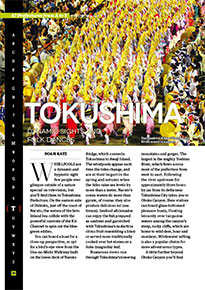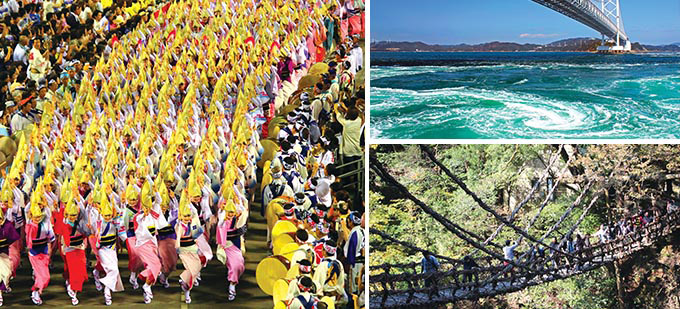Home > Highlighting JAPAN >Highlighting Japan December 2014> 47 Prefectures from A to Y
Highlighting JAPAN

47 Prefectures from A to Y
Tokushima
Dynamic Sights and Folk Dances

Whirlpools are a dynamic and hypnotic sight few people ever glimpse outside of a nature special on television, but you’ll find them in Tokushima Prefecture. On the eastern side of Shikoku, just off the coast of Naruto, the waters of the Seto Inland Sea collide with the powerful currents of the Kii Channel to spin out the blue-green eddies.
You can board a boat for a close-up perspective, or opt for a bird’s-eye view from the Uzu-no-Michi Walkway built on the lower deck of Naruto Bridge, which connects Tokushima to Awaji Island. The whirlpools appear each time the tides change, and are at their largest in the spring and autumn when the tides raise sea levels by more than a meter. Naruto’s ocean waters do more than gyrate, of course: they also produce delicious tai (sea bream). Seafood aficionados can enjoy the fish prepared as sashimi and garnished with Tokushima’s sudachi (a citrus fruit resembling a lime)or served more traditionally cooked over hot stones on a hoba (magnolia) leaf.
Numerous rivers run through Tokushima’s towering mountains and gorges. The largest is the mighty Yoshino River, which flows across most of the prefecture from west to east. Following the river upstream for approximately three hours by car from its delta near Tokushima City takes you to Oboke Canyon. Here visitors can board glass-bottomed pleasure boats, floating leisurely over turquoise waters among the canyon’s steep, rocky cliffs, which are home to wild deer, boar and monkeys. Whitewater rafting is also a popular choice for more adventurous types.
A little further beyond Oboke Canyon you’ll find the Iya Valley and its vine bridges, known as kazurabashi. Heike clan warriors reportedly devised these singular structures when fleeing to Iya about eight centuries ago; the vines could easily be cut by a sword to delay pursuers. Now visitors can cross three such bridges, of which the most accessible one is located in West Iya, and is reinforced with wire for safety reasons. The two others, situated deeper in the mountains of East Iya, are made entirely from vines. Though one can cross them safely, it requires steady nerves, as the bridges creak and sway over the icy waters rushing below.
Tokushima’s largest annual event is the Awa Odori dance that occurs during Japan’s summer holidays. This dance is thought to have its origins in a celebration for the completion of Tokushima Castle in 1587. Though today only ruins of the castle remain, the dance lives on. From August 12 to 15, 1.2 million people gather in downtown Tokushima each year. The town takes on the air of a lively outdoor festival and attracts spectators and dancers from all over Japan, akin to a Japanese version of Rio de Janeiro’s Carnival. Dancers in large groups known as ren perform male and female dance styles along the downtown streets specially cordoned off from automobile traffic.
The dance can be viewed year-round at Awa Odori Kaikan, located at the base of the ropeway leading up to Mount Bizan. Visitors can learn about the dance’s historical development, and are invited to practice with dancers and musicians from the local ren. As residents of Tokushima say, “The dancing fool and the watching fool are both fools, so why not dance?”
A flight from Tokyo to Tokushima takes a little over an hour, and a bus ride of two and a half hours from Osaka does the same, putting the sights of nature and memorable cultural experiences found in no other part of Japan easily within reach.
© 2009 Cabinet Office, Government of Japan






